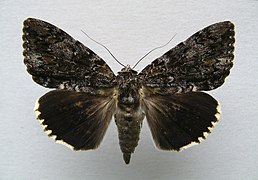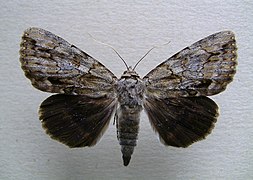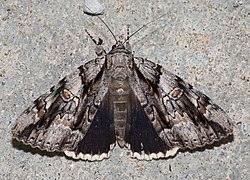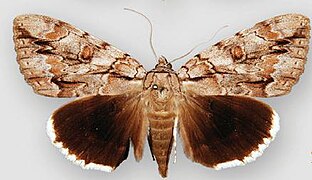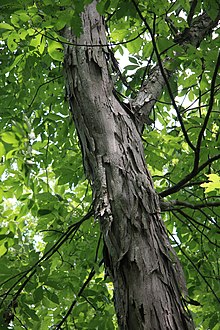Catocala epione
| Catocala epione | ||||||||||||
|---|---|---|---|---|---|---|---|---|---|---|---|---|

Catocala epione in typical resting position |
||||||||||||
| Systematics | ||||||||||||
|
||||||||||||
| Scientific name | ||||||||||||
| Catocala epione | ||||||||||||
| ( Drury , 1773) |
Catocala epione is a butterfly ( moth )found in North Americafrom the family Erebidae, which until 2005 were considered to be the subfamily of the owl butterflies (Noctuidae). The specific epithet refers to Epione , a figure from Greek mythology .
features
butterfly
The moths reach a wingspan of 55 to 65 millimeters. The color of the upper side of the forewing varies from ash-gray to brown-gray or green-gray to black-gray and shows a strong marbling. Inner and outer transverse lines are double, colored black-brown, sometimes whitish or light gray and strongly jagged. Ring and kidney flaws are indistinct, only the sub kidney flaws stand out clearly in light gray. The discal region is mostly darkened. The upper side of the hind wing is black without drawing, the fringes are strikingly silky white.
Caterpillar
The caterpillars are gray-brown to red-brown in color. They show slightly darkened secondary spine lines and small white dots. The brown head has a black, horseshoe-shaped drawing. If the caterpillar hugs a branch, it can hardly be seen by predators.
Similar species
- Catocala lacrymosa shows a black-gray upper surface of the fore wing with little drawing. The fringes of the hind wings are pied black and white.
- Catocala angusi shows a faintly marbled, smoke-gray forewing upper side . The fringes of the hind wings are black.
- Catocala vidua shows black stripes on the dark gray upper side of the fore wing. The fringes of the hind wings are brilliant white.
- In Catocala obscura , the upper side of the forewing is ash gray with little drawing. Marbling is almost completely missing. The fringes of the hind wings are creamy white.
- Catocala retecta shows silky white fringes on the black hind wings, but differs significantly due to the mostly light gray to yellowish gray upper side of the forewings and a strongly spreading W-sign of the outer transverse line.
distribution and habitat
Catocala epione occurs locally in the eastern and some central regions of North America. The species primarily inhabits deciduous forests.
Way of life
The nocturnal, univoltine moths can be found between May and September, mainly in July and August. They visit artificial light sources and are very fond of bait . During the day they prefer to rest on tree trunks, on which they can hardly be recognized by predators due to their color and the folded wings over the abdomen. The eggs are deposited under the bark of the food trees, where they overwinter. The caterpillars hatch in spring and feed on the leaves of various species of hickory ( Carya ), primarily Carya ovata . The pupation takes place under foliage.
Individual evidence
- ↑ a b Information on Art
- ^ Butterflies and Moths of North America
- ↑ caterpillar
- ↑ Flight time at iNaturalist
Web links
- mothphotographersgroup - Mississippi State University site data and photos
- funet.fi - dissemination

